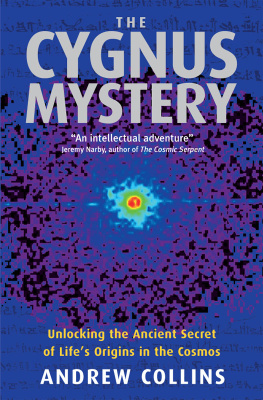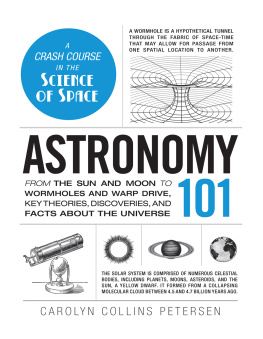Andrew Collins is a popular writer of history, archaeology and science. For over 30 years he has explored the relationship between archaic religious beliefs and the cosmos, examining the origins of human civilization, the development of technology and the inspirations behind magic and religion. His discoveries have led to several thought-provoking books that challenge the way we think about the past. Andrew is also the organizer of the Questing Conference, Britains premier event on revisionist history, forbidden archaeology and ancient wisdom. Born in 1957, he lives with his wife Sue in Essex.
List of illustrations
Map of Egypt and the Near East.
Mural of Neolithic excarnation tower from atal Hyk, southern Turkey.
3a and 3b. Two 19th-century impressions of the Yezidi sanjak .
Neolithic stone totem pole crowned by vulture, from Nevali ori, southeast Turkey.
The northern sky as viewed from southeast Turkey, c .9400 bc .
Yezidi symbol representing the game bird identified in Arabian lore with Cygnus.
Graeco-Roman magical gem depicting the crucified Orpheus.
The precession of the poles, showing previous pole stars.
The Blackfoot Wolf Trail, representing the Milky Way and, probably, Cygnus.
Great Circle enclosing Eagle Mound, Newark, Ohio.
The Milky Way rising to reach Cygnus before midsummer dawn, as viewed from Great Circle, Newark, 100 bc .
Ancient Native American petroglyphs of the Birds Foot, compared with the stars of Cygnus.
Wooden swans on sky-poles erected by Reindeer Tungus shamans.
Rock engravings from Lake Onega, Russia, showing swans and a shaman on a sky-pole.
The northern sky as viewed from Mexico at midnight on midsummers night, 2000 bc .
Plan of the Olmec city of La Venta.
Olmec votive axe in the form of the were-jaguar, with faint crossed bands symbol on chest.
Olmec image of a serpent with crossed bands symbol as an eye.
The Maya cosmic bird at the top of the World Tree, representing the Milky Way from Scorpio to Cygnus.
Cuzco as the City of the Puma, symbol of the axis mundi , linked to Cygnus.
Avebury monument by William Stukeley, 1743.
Artist Alan Sorrells impression of Avebury.
The northern sky as viewed from Avebury, 2600 bc .
Avebury stone # 25S with carved image of a swan-like creature.
Artists impression of carving on Avebury stone # 25S, after Wakefield.
Wine jug from a Roman temple of Isis, London.
Panel from the Franks Casket ( c .AD 700750), with egil catching swans for his brother Vland.
The birds foot rune eolhx signifying a Valkyrie swan-maiden.
Aerial view of Callanish from the north.
The northern sky as viewed from Callanish in 3000 bc .
The northern constellations, including Cygnus and Ursa Major, from the tomb of Senmut in Western Thebes, Egypt, c. 1490 c. 1468 bc .
Graeco-Egyptian magical gem showing the Phoenix as the Benu bird.
The god Sokar, underworld guardian of ancient Rostau (Giza), from the tomb of Thutmose III ( c .1490 c .1436 bc ), Western Thebes.
Giza, Ausim (Letopolis) and el-Matariyeh (Heliopolis) in relation to the meridian and the rising and setting of Cygnus and Ursa Major, 2600 bc .
The Dendera round zodiac, showing the mace-man Cygnus, after Aubourg.
The sky goddess Nut and the Earth god Geb, with the Great Cackler, from the Papyrus of Tameniu, c .1000 bc .
Nut pouring liquid from the sacred sycamore tree, from the Papyrus of Ani, c. 1300 bc .
Ronald A Wells concept of the Milky Way representing the goddess Nut.
The goddess Saraswati, personification of the Milky Way, on her swan vehicle.
The river systems of India and Pakistan, showing the possible course of the ancient Saraswati River.
The four beasts of Chinese astronomy, with constellations.
Cygnus as Tianjin, the Ford of the Sky.
The Weaver Princess on the Magpie Bridge, represented in Chinese astronomy by Tianjin (Cygnus).
Rock art of dancers holding mushrooms from the Tassili-nAjjer region, southern Algeria, c. 7000 c. 5000 bc .
Tassili-nAjjer figure with mushrooms in his hands and around his body.
46a and 46b. Neolithic inscribed tablets from Jerf el-Ahmar, northern Syria, c. 8000 c. 7300 bc , showing mushroom imagery.
Stone head from Nevali ori, Turkey, showing snake-like ponytail.
Standing pillar at Gbekli Tepe, Turkey, showing mushroom-headed serpents and mushroom interlace, c .9500- c. 7300 bc .
Palaeolithic bone swan pendant from Malta, Siberia, c .15,000 BP.
Artists impression of a high-mass X-ray binary system like Cygnus X-3.
Micrograph of a cosmic ray tracked on emulsion.
(Appendix) The Dogon Fork of Space, seat of the creator god, overlaid with the principal stars of Cygnus.
list of plates
Gbekli Tepe, designated the oldest temple in the world, southeast Turkey.
Gbekli Tepe looking south.
Interior of Gbekli Tepes lower cult building.
Stone pillar from Gbekli Tepe with leonine carving.
Stone pillar from Gbekli Tepe with relief of fox.
Carved vulture head found at Gbekli Tepe.
The Astronomical Tower at Harran, southeast Turkey.
The author at the entrance to Harrans Astronomical Tower.
Unexcavated stone row, Karahan Tepe, southeast Turkey.
Mushroom-shaped stone pillar, Karahan Tepe.
Cygnus as the celestial swan.
Cygnus as Christ crucified.
Ind Raymi, the Festival of the Sun, at Cuzco, Peru.
The Avebury monument, Wiltshire, England.
Wayland Smithy long barrow, Berkshire, England.
Callanish stone circle, Outer Hebrides, Scotland.
Banner and stuffed swan associated with the Swan Upping ceremony on the Thames.
The Giza pyramids from the southwest.
The principal stars of Cygnus and Orion overlaid on the Giza pyramid field.
The Giza plateau, looking south from the Great Sphinx towards the hill Gebel Ghibli.
The holy well of Beer el-Samman, Giza.
The Hindu creator-god Brahma riding the swan-goose Hamsa.
Stone relief from Gbekli Tepe of a barren female with mushroom-shaped hair.
The Well Scene at the cave of Lascaux, France.
Creswell Crags, site of Britains first Palaeolithic cave art.
Carved ibis head, Church Hole, Creswell Crags.
Carved swan-bittern chimeras, Church Hole, Creswell Crags.
Image of the high-mass X-ray binary system Cygnus X-3.
Artists impression of a microblazar like Cygnus X-3.
Image of a relativistic jet from the supermassive black hole in the galaxy M87.
Marcel Griaules 1931 photo of Dogon rock art possibly showing the Milky Way.
Snake emerging from the mouth of a head, Rouffignac cave, France.
PICTURE CREDITS
The author wishes to thank the following for permission to use their images in this book:
Illustrations: 4, 39, 43, Yuri Leitch; 7, Bildarchiv Preussischer Kulturbesitz, Berlin; 9, Greg Little; 13, E J Lindgren-Utsi; 14, Herbert Kuhn; 22, Alan Sorrell/Richard Sorrell; 29, John Dewer/RCAHMS; 35, ric Aubourg; 36, British Museum; 44, 45, Jean-Dominique Lajoux; 47, Harald Hauptmann; 48 a & b, German Archaeological Institute (DAI); 50, NASA.













